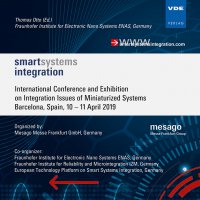Wireless power supply for a RFID based sensor platform
Conference: Smart Systems Integration - 13th International Conference & Exhibition on Integration Issues of Miniaturized Systems
04/10/2019 - 04/11/2019 at Barcelona, Spain
Proceedings: Smart Systems Integration
Pages: 4Language: englishTyp: PDF
Personal VDE Members are entitled to a 10% discount on this title
Authors:
Schmidt, Marco; Hedayat, Christian (Fraunhofer ENAS-ASE, Warburger Str. 100, 33098 Paderborn, Germany)
Petrov, Dmitry; Hilleringmann, Ulrich (Fraunhofer ENAS-ASE, Warburger Str. 100, 33098 Paderborn, Germany & Paderborn University, Sensor Technology Group, Warburger Str. 100, Paderborn, Germany)
Otto, Thomas (Fraunhofer ENAS, Technologie-Campus 3, 09126 Chemnitz, Germany)
Abstract:
Fraunhofer ENAS and the Sensor Technology Group of Paderborn University in cooperation with multiple industry partners are involved in a research project for the development of an RFID based sensor platform, supporting the wireless power supply. The goal of the project was to control and monitor prodcuts in a production line by a sensor platform with an RFID interface. To communicate with the sensor platform an external control and communication unit was implemented, which has an OPC interface to the production system and which could communicate over RFID with the sensor platform. Depended of the application, the developed sensor platform can be equipped with different analogue and digital sensors, such as analogue UV sensors, a MEMS based accelerometer or other sensors like humidity, light and temperature sensors. For this purpose, the sensor platform should be encapsulated in a dust- and water-proof enclosure or even integrated into workpiece carriers. However, the sensors and the microcontroller require energy when series of measurements are taken or recorded, lasting from a few seconds to some minutes. The necessary energy is provided by the Li-Po battery, which must be charged regularly. Since the connection to a charging cable or other external electrical contacts would be difficult, as the workpieces move along the production line, a wireless power transmission system was developed.


